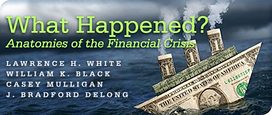There is one huge argument against the claim that the crash in the mortgage market was in some sense the fault of excessively risky lending by the GSEs Fannie Mae and Freddie Mac which pulled the private sector along behind them: it is that Fannie Mae and Freddie Mac lost market share as all the loans that have now gone bad were made.

As Milton Friedman always used to say: supply curves slope up, and demand curves slope down. If something is due to a change in supply that causes movement along the demand curve, price will go down and quantity will go up. If something is due to a change in demand that causes movement along a supply curve, price will go down and quantity will go down.
Between 2001 and 2006 the “price” at which Fannie Mae and Freddie Mac sold mortgages — the terms they set — certainly went down. But did the quantity go up? No: Fannie Mae and Freddie Mac together had made a much smaller share of mortgages in 2006 than in 2001: 37 percent as opposed to 48 percent. Price went down, and quantity went down.
This means that the dominant feature of the mortgage market in the 2000s was not an expansion of supply by Fannie Mae and Freddie Mac pushing their implicit government guarantee past the limits of prudence, but was a reduction in demand for Fannie Mae and Freddie Mac’s products as private-sector mortgage lenders aggressively pursued and took away their markets.
At least, this is the dominant feature if you follow Milton Friedman and believe that typically supply curves slope up and demand curves slope down.

